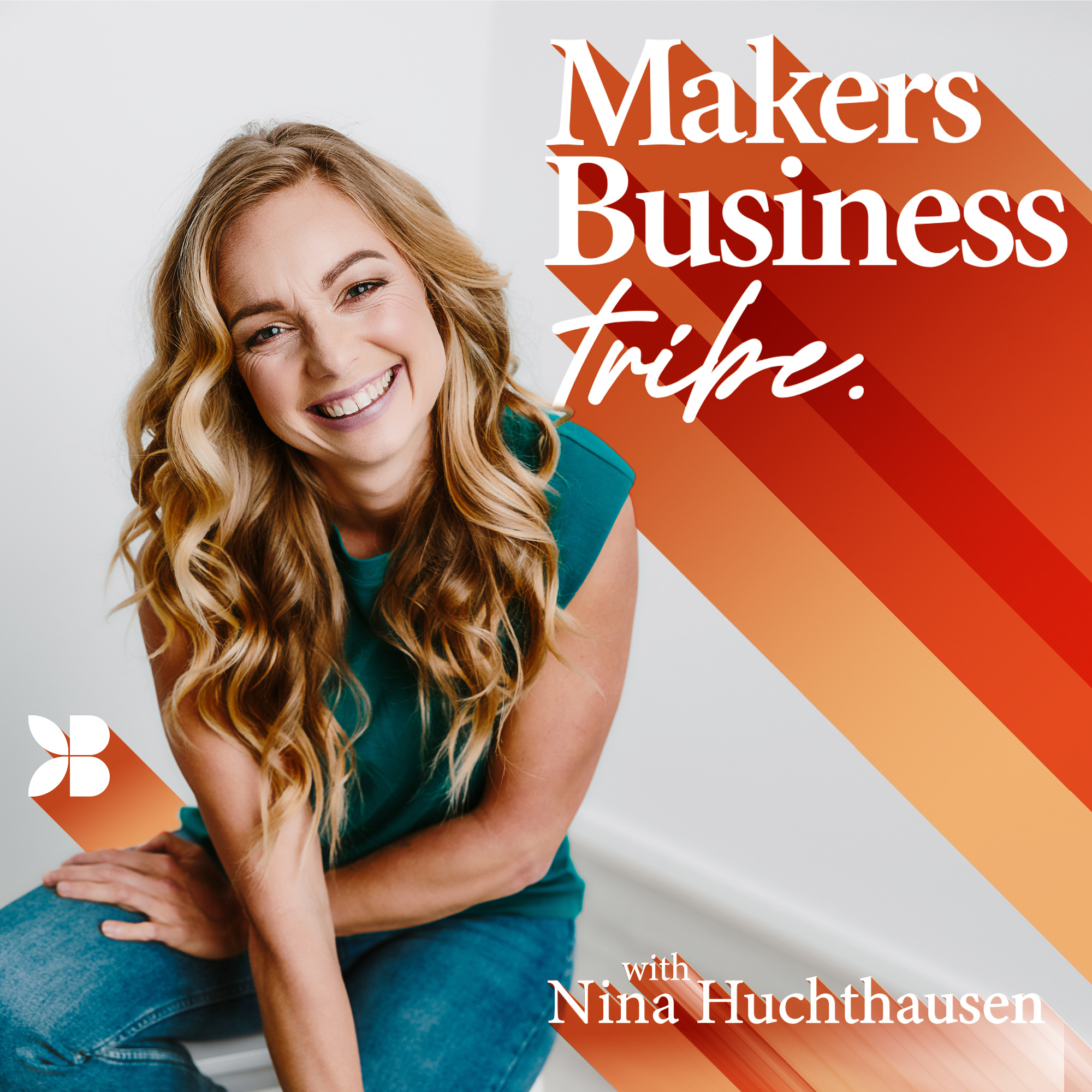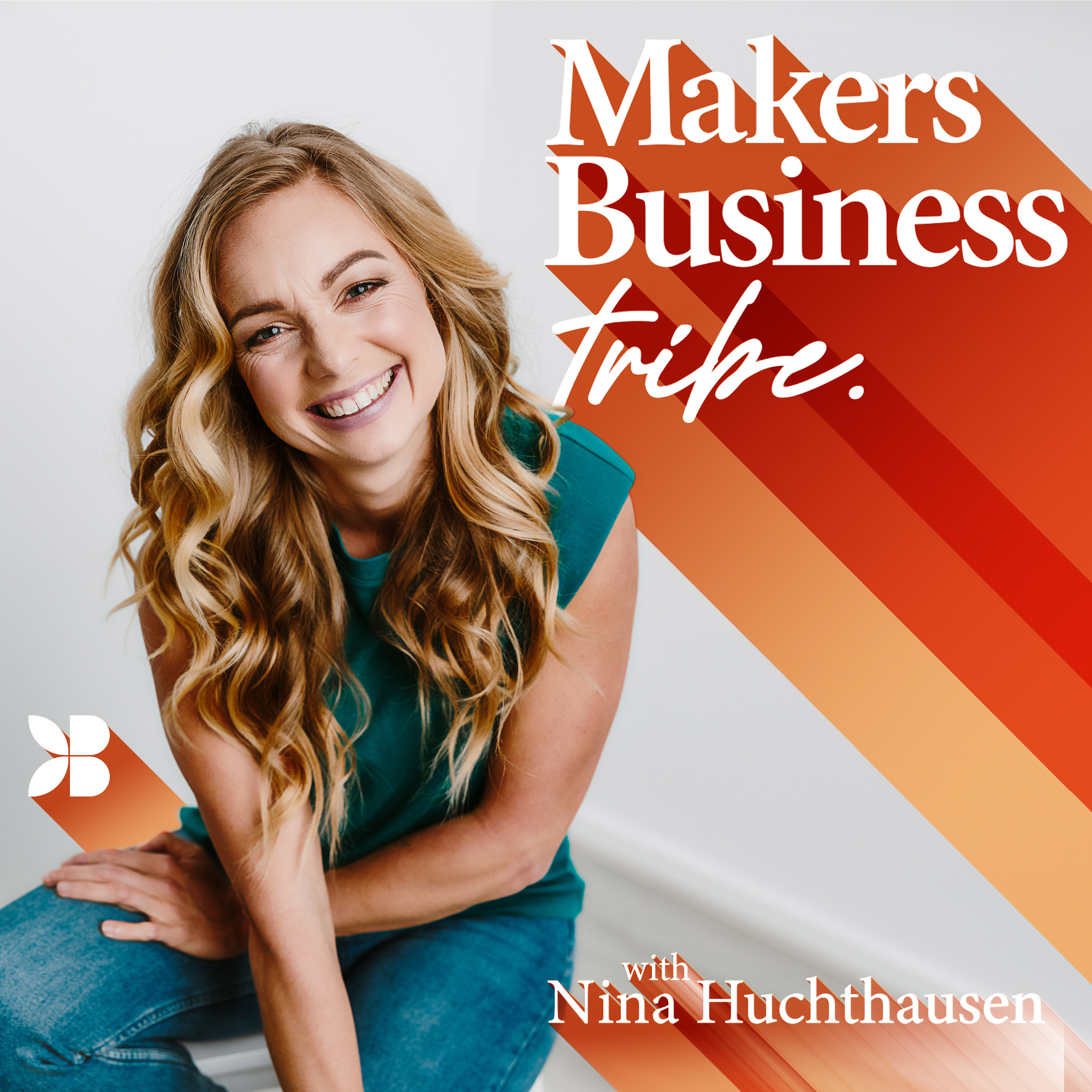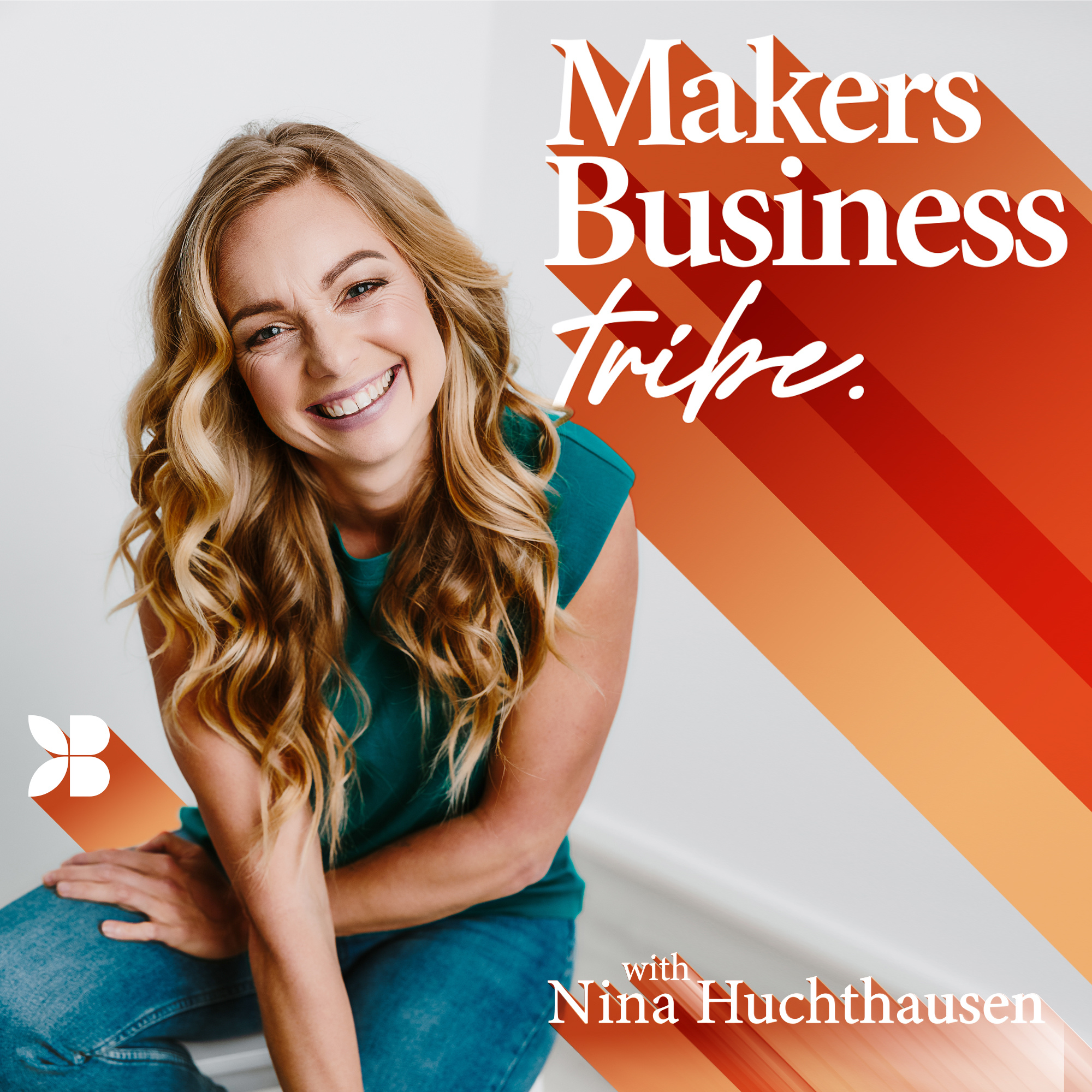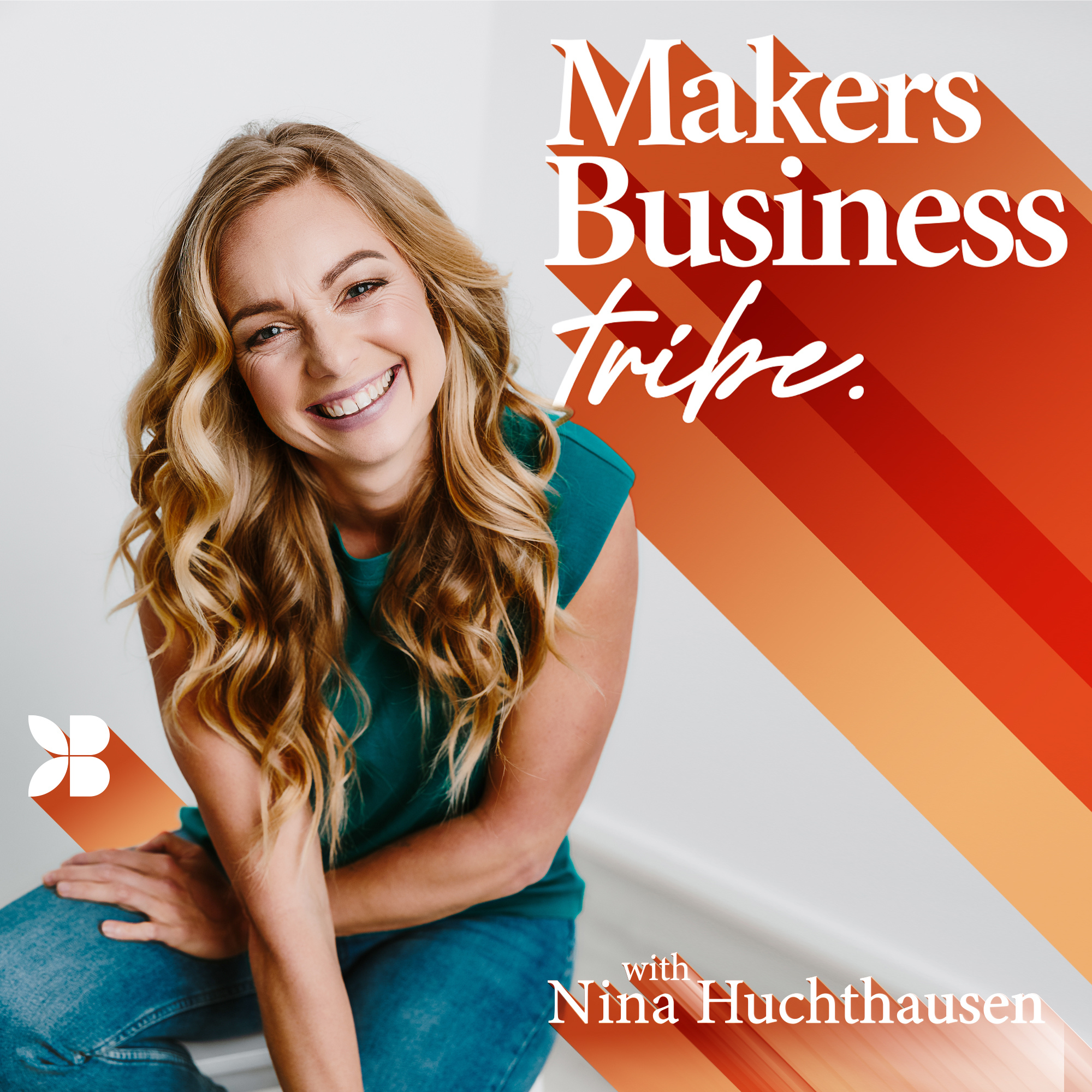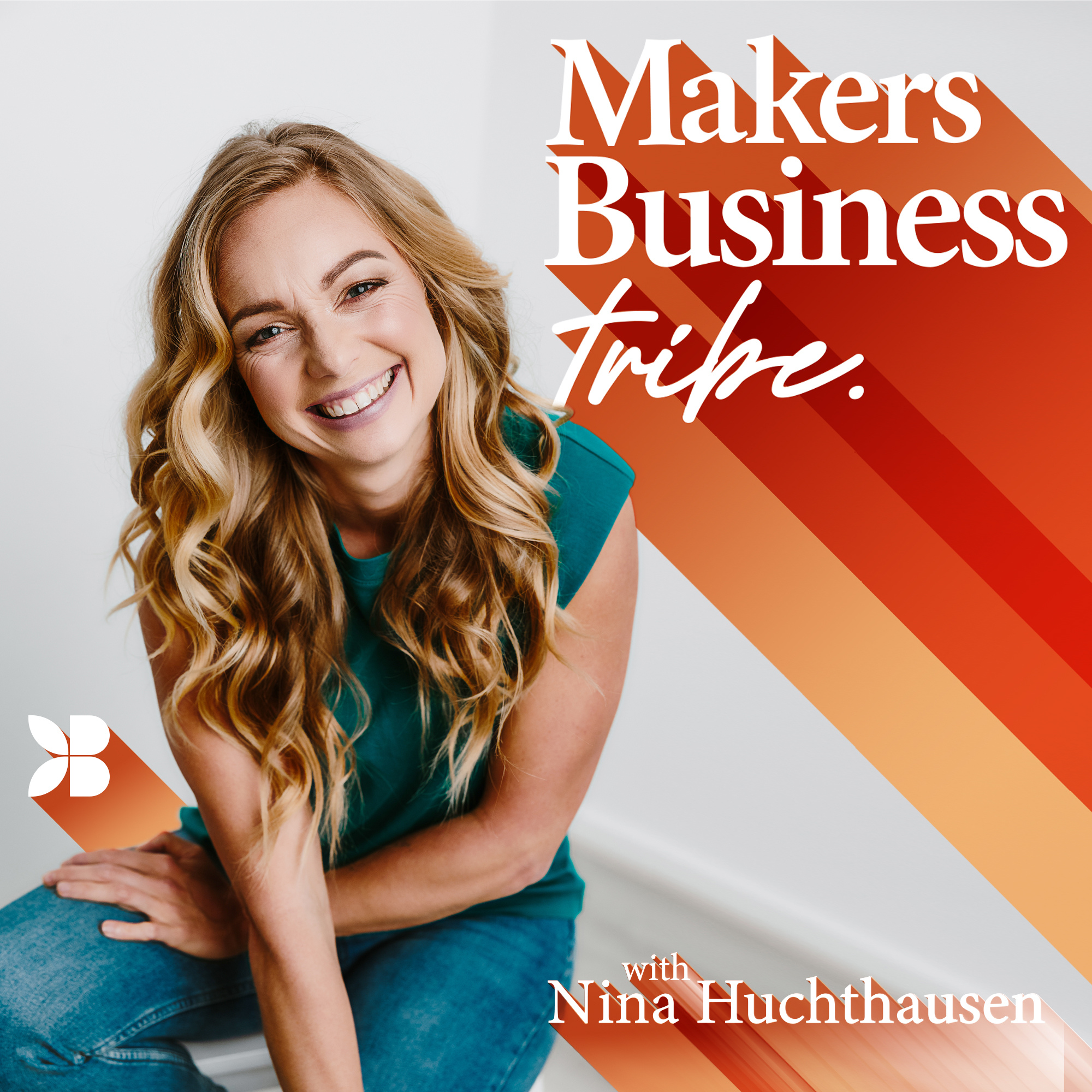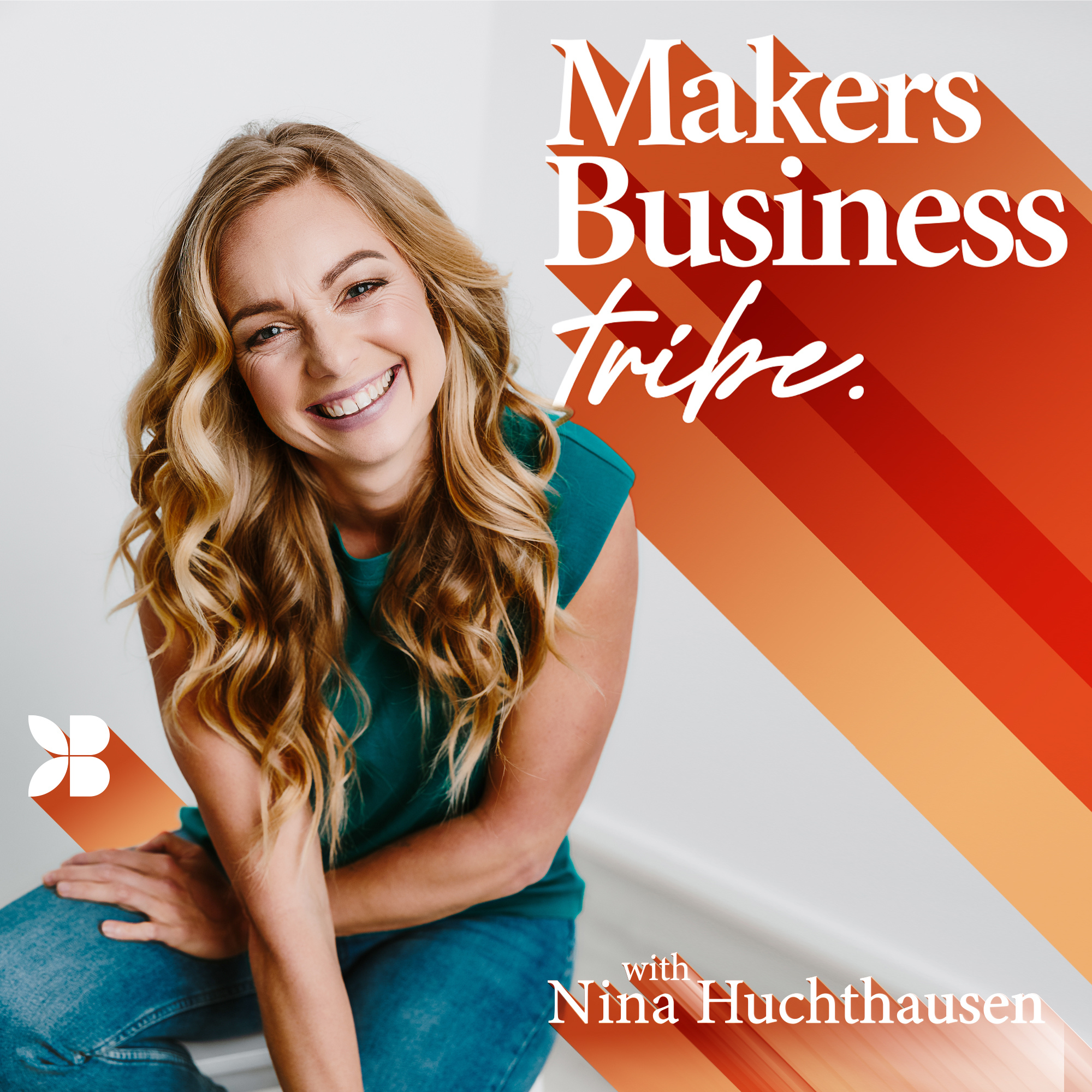Episode Transcript
Nina Huchthausen (00:31.214)
Hello everyone and welcome to the Makers Business Tribe. My name is Nina and in today's episode I would like to share with you some key tips and tricks for you to self -diagnose if your sales, your retail sales are not where you want them to be. Now we hear this with our Tribe members.
all the time that once they start getting out and bringing in retailers that either their sales seem to be slow or their customers don't get back to them or they're just not hitting their targets or quite often they jump straight into solution mode and ask other tribe members or ourselves on how can I boost my sales? And yes, of course,
course, we can always just ask people for some for some ideas for what can we do? What can we do? But without first stepping back and diagnosing on what is the cause? What is not working in our what I always call chain of events yet for you to reach the goals that you want to reach, which is the ultimate outcome that end state.
It's very easy to, number one, feel incredibly overwhelmed because we feel like we're standing in front of this huge mountain and we have no idea as to how to conquer it. Or number two, to just throw random ideas against the wall and hope that something sticks and something works out. Now, so what we want to do instead is,
Whenever, whenever we are not hitting a target, and that might not just be your retail target, it could be an online target, it could be an internal goal that you have or broader, larger revenue or business expansion goal. Whenever you got a goal and you're not there yet, here's what I want you to do. So number one, the first thing is we need to step back and out of our sense of overwhelm and
Nina Huchthausen (02:54.51)
frustration or fear or anxiety or whatever that internal turmoil is, that's literally just there to signal us, Hi, we got some, we have an expectation or we had an expectation, we had a dream or an idea of what was supposed to be there today, but it's not there yet. So our emotions,
are there to show us, my gosh, we got this idea, but it's not there. There is a gap. We're feeling internally that gap. But if we're just acting based on our emotions, in most of the time, we just start to work harder. We do more. We tend to get more random, more reactive. And oftentimes, that just tires us out and we create more frustration.
or potentially make the wrong decisions. Whenever you are noticing that, we got to step out. We got to step back, leave the office, leave in whatever space you are normally in doing mode and step out of there. Okay. First thing, because what you need for you to see what's not working or not working yet.
or where the opportunities lie, or where you can improve, shift, change, you need to find a vantage point. So a vantage point from which you can see and take an eagle eye view and view the situation for what it is. When you're in your space, and most of the time, like right now, I'm in my office. In my office, I'm in execution mode.
From in here, I cannot see what I'm doing wrong, what I'm missing, what I'm not doing, what I should be doing. But if we're stepping away and then being able to objectively observe of what's happening, what's not happening, it's much easier for us to, number one, be able to assess the situation.
Nina Huchthausen (05:14.67)
look at the symptoms from different angles and then being able to find the actual problem and the cause, the problem or that whatever has caused for us to not reach the outcome, the goal, the target. Yeah.
And once we can see that from our vantage point, then it's much easier to identify what are our weak links? What are the things that might not create the biggest return on investment? What are the things that we might have been shying away for or have shied away for? Or what are the things that we just don't know that we need to learn about that we need to build? Which...
That is the case probably 90 % of the time. Because if you're starting out in business for the very first time, there's so many things you've never done before. You just don't know. Nobody has told you yet. And you're just figuring it out as you go. So oftentimes when we don't hit a target, it might just be there's something we haven't figured out yet. We need to learn. And that's totally cool that we only see that when we start back.
And then more objectively kind of like look at ourselves. And then from that point, once we've unpacked those weak links, it's much easier to find help or guidance or support to take the right action to address the problem at hand, the gap, the thing that you need to build.
that you can objectively see in your path so you can close your gap and reach a goal in the future. Because the words that might come of our mouth when we say, my gosh, I'm not selling enough, or my gosh, how can I boost my sales? Everybody, give me some tips. We see that on Facebook all the time where people post, hey, what tips do you have? What can I do?
Nina Huchthausen (07:30.286)
But you could do anything and everything. If you don't know what the problem is, gosh, you could be doing things for years without actually getting to your goal because you're not fixing the problem.
I hope that makes sense so far. So how do we do this, though? How do we, especially if we're one man band, you might be one man, two men, three men band, how do we do that? How do we, instead of reacting, stepping back, taking advantage point, and what is it before, finding the cause? How do you do that? So.
I want to take you through. Okay. So bet I would say best is take a pen and paper so you can write down my process. I will post a summary in the, in the description as well, but best, I would say best to take a pen and paper and start writing things out. And maybe you will even want to pass this podcast because it's very action focused. Yeah. I don't do just fluffy stuff. We want to take action.
Because if there's anything in your business right now that is not bang on, this tool will really help you. Okay? So here's how it goes. Step number one.
Sit down with a piece of paper and just write out what are the symptoms, the challenges that come up. And in our case, because we're talking retail, what's happening in retail right now? Is it just sales is not there? But the question is, what else? What else is not freaking bang on, super exciting, like 10 out of 10? Yeah, just write down those key points.
Nina Huchthausen (09:28.078)
And they might all be super surface level. Yeah. They might be like, I'm not hitting my revenue targets. Like my budget has so many holes, I'm spending too much money or I don't have enough time. Whatever those symptoms are. I'm stressed out. People are not getting back to me. Whatever it is, just write out that list of like those, those.
random frustrations or struggles that you might be going through. They might not be random, but whatever comes up, yeah, they don't need to make sense. Just write them out. Okay.
Nina Huchthausen (10:15.375)
And once you've written that out, then I want you to leave the office. Leave the office and go someplace else where you can now actually take advantage point. If you have a business partner, if you have anyone to talk this out with, a business coach, your accountant, whoever, sit down with them. After you've written it out, then you want to sit down with them. If you don't have that totally cool, go somewhere else, take advantage point.
where you feel a little bit more clear headed. Maybe that's by the ocean or in a cafe, somewhere where you can slow down your mind. OK? And the first thing I want you to do, and it might sound a little bit woo -woo, but give yourself the acknowledgement that you are now ready to hear and find out what the problem is.
You are here for yourself. You are here for your business. You're in the service of your business, your customers, the dream that you're creating. And you are actually now giving yourself permission to step back and find out. Yeah. We're not here to just fix everything with a hammer. We're trying to find out what is happening. OK.
Because we're now on a mission to zoom out, look at all the different symptoms, and find the cause. So how do we do that? After we've been looking at all these symptoms, and we might have no idea what the problem is. We're just seeing all this mess. So first thing, I'd like you to write out or to look at or sense check.
What is your actual goal for this month or for this quarter?
Nina Huchthausen (12:13.327)
Have you written that down? Have you taken the time before the quarter or the month started and write down what your key goal specifically is in terms of numbers, in terms of dates, and being really specific and super clear? Do you know what you are aiming towards? It might sound silly, but a lot of times when we have a conversation with our tribe members,
and ask them, OK, cool, you are not hitting your target. And we're asking, what is your target? They go silent because they actually haven't taken the time to write out what the goal is they want to reach. And that's trouble. Why is that trouble? If I don't know what I'm aiming for, or maybe roughly, you kind of have an idea what you want to aim for. But if you haven't sat down and written that out properly,
then probably highly likely if I now ask you, have you created a detailed plan or a step plane or even high level plan as to how you get from where you are to where you want to be, you might probably say, no, I haven't because I've been busy because I've been doing that because I've been attending to my customers, whatever that is. But my friends,
If we don't have a plan as to how do we get from A to B, what is the likelihood getting from A to B meaning where you are today to where you want to be?
Nina Huchthausen (13:50.959)
Probably way less likely than if you did have a plan. It's the same situation if you want to drive from wherever you are based to Rome.
But you don't take the time to even decide you want to get to Rome. You just have some rough idea, you know, maybe Europe. But then number two, that might sound completely ridiculous. You don't take the time to look at the map to figure out what the path is, to figure out you actually need to book a plane ticket, you need transport from and to the airport, and...
and you might also need to put all sorts of other things in place in order to do that, such as even putting some money aside to pay for the plane ticket, to pay for the transportation, to pay for all sorts of other things for your visa and so forth. If you just have this rough idea, let me get to wherever I want to get to and then don't do anything else and you just start walking or maybe running.
someplace without knowing where to what's the likelihood you're going to get there? Ridiculous you wouldn't do it. So but has that potentially happened in your business? Yes, no If you don't have clear goals in place with deadlines if you don't have a plan in place and that's where you need to start Yeah
Nina Huchthausen (15:29.839)
So, but we also want to make sure we've broken the goals down to a degree to make them more tangible. So what does that mean? If we have a revenue goal of 15K, well, you want to at least break that down per channel. You want to break that down for your online channel. You want to break that down maybe for you, if you sell via email, you want to break that down if you're selling at markets, you want to break that down if you're selling retail.
and potentially there are different categories in retail. Yeah. So how do you break down? How much money do you want to make in each category? That's important because then you can get to work and work backwards. Okay. If you want to make, 10 K K in retail sales, and you've got two different categories that you want to do that with, let's say gym and health food stores, but how much in gym, how much in health food stores, and you can break that down. And then.
We can easily see, okay, cool. Well, what is our average revenue per retail or stockist customer in a gym versus in a health food store? In a gym might be $500 per order. In a health food store might be $1 ,000 per order. So.
If you're overarching retail revenue, I can't remember what I said before, but I'm just going to say 10, 10 grand. Yeah. If that is your number and you have a thousand dollars of average retail order, that means you need to get it for, for a health food store. That means you need to get either 10 stock is to order once. Or if for a gym, if it's $500, then you need to get 20 gyms.
shorter ones or somewhere in between.
Nina Huchthausen (17:28.783)
somewhere in between. Now question for you, and you can just write that down, no judgment, but do you know how many retail orders do your stock needs to place in its entirety based on your average retail revenue order so that you can reach your monthly goal?
Yes, no. If not, then you want to work that out and you can easily just check. Okay, if you based on you could just make some calculations based on your intro offer. Yeah. Or take a look at if you already have some really good numbers in place for your average retail revenue, then you can just divide your target revenue divided by your average revenue per order that gives you the total number that need to be hit.
Okay, very, very, very important to know this because then, my goodness, and this is where it gets exciting. We can then also break that down per week, right? Because let's say we are figuring out, okay, I need to get 10 orders in, or 10 orders over 30 days. That means.
What does that, what would that look like on a weekly basis? How many orders on a weekly basis? That might be literally, two and a half per week. If we're going into a four week, if it's four weeks for the month. Okay. So we're two and a half per week. Well,
Then the question becomes, okay, how many retailers do I need to reach out to?
Nina Huchthausen (19:30.031)
to get two and a half orders per weekend.
And that's where it becomes interesting because my next question would be, are you tracking?
what your chain of events looks like from that first cold outreach that you might do on the phone or via email to how many retailers pick up the phone to how many retailers you then actually pitch to the pitch over the phone or face to face to how many people retailers are saying yes.
And you might just listen to me right now and be like, what is she on about?
Probably 80 % of the people that I talk with don't track that because that feels that can be a bit cumbersome now. And that's totally fine. But if we don't know what our sales success rate is, and we just every month, we're just saying, okay, I'm just going to call as many as possible. And I hope for the best that I'm hitting my targets.
Nina Huchthausen (20:41.647)
That's also really tricky to actually work out because you might just then because of that get really random and call random retailers and it might not work out or you are also not very rigorous on your sales tools, meaning how you reach out to retailers, how you follow up, the script that you use, the key conversations you have and how and.
how you are actually leading retailers to say.
Nina Huchthausen (21:15.215)
because you don't know any, do any of these tools work. So the next thing that we want to look at, and I would just assume you might not have that in place is start sitting down and you could maybe look backwards over the last 30 days and note down for yourself. Number one, so write this down for me. How many retailers have you reached out to?
via phone first or via email or visit it in store straight away. How many retailers, total number of retailers have you pitched to? How many retailers placed an order because of that?
Let's say you reached out to 30 retailers and three said yes. That means one in 10, right? That means if that was your ratio, you need to reach out to 10 retailers to get one yes. Because you reached out to 30, you got three yeses, three orders. Yeah. If that was your ratio, amazing. I'm not judging whether that's good or bad.
But what that ratio tells us, if you need to get 10 orders in, you need to reach out. If we are just looking at new retailers onboarding, yeah? You need to reach out to 100 over the course of the month to get 10 orders in.
Nina Huchthausen (22:56.719)
How powerful is that to know?
Hmm?
Nina Huchthausen (23:04.815)
So that means probably on average per week, we need to reach out to 25. Yeah. If you have a five day week, you need to reach out to five retailers every day, Monday to Friday, in order to hit those numbers.
Nina Huchthausen (23:27.919)
I'm just pausing here because I'd like you to think about number one, what is your ratio? And number two, do you know your ratio? And number three, are you planning your week in a way to know that if you're sticking to your ratio,
how many retailers you need to contact in order to close enough deal by the end of the month in order to reach your retail revenue target.
Nina Huchthausen (24:01.007)
You might be saying yes, or you might be saying no. If not, this is a great opportunity to just pause this podcast right here and write this down. Write out, figure out the key numbers that I just mentioned.
Nina Huchthausen (24:23.503)
And then you can also take a look at those numbers and decide for yourself, are these numbers good? Is reaching out to 10 closing one deal, is that good? Or can I improve? Is there opportunity for me to improve those numbers because spending, doing five calls a day in order to get 10 orders by the end of the month is that.
the best I can do or where would I potentially improve my sales flow or tools or conversations or offer in order to improve those numbers to get more return on investment. That's what once you've written down those numbers, you can start asking yourself because when we start looking at these and let's say you have you, you're
you can you have both gym and health food stores you can do those numbers and split them out for gym and for health food stores so you could see okay well are they the exact same ratios or is one category performing better than the other my goodness let's say for a gym is actually five to one well
Then you could have a look and see, okay, well, am I using the same pitch both for gyms and health food stores? Maybe I developed the pitch for gyms. That's why the pitch is working so well. And so you could then see, okay, well, is it worthwhile taking the time to change my pitch for health food stores so it's adapted?
So because potentially you could then be looking at, well, do health food stores face the same challenges as gyms? What's resonating with the gym owners so much that's not resonating with my health food store owners? Maybe I'm paying to make a change there. Or you could take a look at, well, is the first part of my pitch really good and everybody's really interested, but there are less health food stores taking up my offer versus the gym.
Nina Huchthausen (26:41.679)
All right, well, why is that? What's less attractive for a health food store owner versus a gym owner? Maybe let's take a look at that. Is it, you know, the average order or is it my minimum offer that is not as attractive for a health food store owner versus for a gym? Is the positioning of my product maybe
not meeting what a health food store owner needs versus a gym owner.
Nina Huchthausen (27:21.743)
Or potentially, am I reaching out to health food store owners at the worst time ever? Could it be a timing thing? Or do health food store owners just take longer in order to say yes to my offer? What is it? So you can literally take a look once you have those numbers and ask yourself some key questions to unpack the origami and see, well,
What is working well and what isn't working well? Where does the drop off occur? Do people, does it, is it just really slow because at the very start and you keep reaching out and reaching out over the phone, but it's really hard for people to, to want to have a further conversation with you. Well, if that's the case, can you take a look at your first outreach pitch? Do you have a first outreach pitch or do you wing it every time?
Well, potentially, if you wing it every time, you might want to get a bit more scientific. Write down what you say. Can you record what you say? Can you listen to what you're saying and find some gaps in there? Or potentially, do you, once you meet people face to face, that then it kind of like gets a bit plunky. Again, could you record yourself?
Did you bring a little microphone? Just record what you're saying so afterwards you have better opportunity to reflect and see, well, am I taking leadership in this conversation or am I getting stuck trying to build rapport, talking about the weather or where am I falling down?
The numbers will tell you first because you will see some wonky spikes in there. And then you can start unpacking and asking yourself some really good questions. The questions that I just mentioned. And of course, there are many, many more. But based on what you're observing in your numbers,
Nina Huchthausen (29:22.287)
Rather than you just thinking about random solutions, you can at least show those numbers to some other people in your network and ask them, what do you see in here? Where can I dig deeper to find the problem, to find the actual problem that is holding me back from reaching my goals?
But I also trust your intuition by once you start looking at those numbers, and that's what tends to happen with our tribe members every single time when they start looking at those numbers and reflecting on conversations and reflecting on where they're getting stuck, that they will tend to find their own answers. So I trust that will happen with you too.
Nina Huchthausen (30:12.847)
And then lastly, and I think I already slightly touched upon this, but I want to pull it apart as a separate point, is your conversation scripts. So your conversation scripts are similar to writing yourself a recipe. Yeah, let's imagine you are, you make skincare. I for certain, for you,
to guarantee consistent, reliable results with your product, you have very specific formulas that you follow every single time when you make your skincare. You're not just making it up and making it different every single time. And that's how I'd like you to see your conversation scripts. Now, what are conversation scripts? Conversation script could be a loose guide as to how you approach your conversation.
when you reach out to someone on the phone for the very first time. What is that conversation like? How are you guiding someone from just connecting with you over the phone to being open to receiving your wholesale catalog or being open to have a longer conversation about your product? What is that formula there? Very important for you to map out a flow and test that flow and then get really good at that flow.
and keep testing and refining. You want to tinker there because there is a really good way of doing this or a not so good way of doing this. Okay. And it's not so good when you get really bad results and it's really good when you get awesome results. Okay. So you want to have a script there. Second one, when you sent your email, whether that is your cold outreach email or follow up email.
There's also a method to the madness there because you will notice for yourself if you get a great response rate, then what you're doing works. Formulated or if it's not working, you can change your formula. Then you really want to have a bit of a master script for your phone pitches. Yeah, because when you talk to someone about your partner, you want to pitch to them to purchase. You need to lead them. You need to lead them.
Nina Huchthausen (32:39.951)
from understanding why your brand, why your products, why are they so unique and different and powerful, what they are all about, how they work, what that offer is, who else loves it, what's in it for the retailer.
all the way to them loving the product, loving the offer and giving you a yes. Yes. And then following through with placing that order. That's your leadership. You need to lead them and guide them on that path. They don't know what's happening. They don't know why they're here. They are just in the business of gathering some information from you. So they might just, if you don't lead, ask you some random, random, random questions. And after that, they're like,
OK, I got some information. I will get back to you. I will get back to you means you haven't let them from where you wanted to start to where you want to get them to. And once you write out what the formula is, the path is, the script, the conversation, then you can see, well, do you have a path? Do you have a method? And then you can also see and continuously tinker and refine that script the more you use it, because you will start noticing,
Where is it falling apart? OK. So you want to have that both for phone and face to face. And the last thing is your email follow up scripts to then actually pull through the deal. If you haven't been able to pull through the deal in the store on the phone right then and there, you want to have some really good follow up emails to get them through, to get them placed that deal. And same as previous applies.
very important to have a framework there so you can continuously test and learn, see what works, what doesn't work. And if you're noticing people are dropping off after they've said yes, then refine that email and make it work for you.
Nina Huchthausen (34:43.407)
So that my friends, if you are getting stuck with not reaching your retail revenue goals, then this is what I want you to do. Write down first what your symptoms are. Number two, take advantage point. Number three, look at, do you have a goal? Do you have a plan? Do you have your numbers broken down?
then I want you to analyze those numbers and find the problems so you can ideate some solutions. And last point, look at your conversations. Do you have scripts? Do you have a method for the madness to it? And once you've analyzed all of that and tweaked all of those numbers, I can guarantee you, you will get much closer to your revenue goals than you have ever before, because now your chain of events, you are actually looking at.
and looking at and keep tinkering with the steps that I needed to get from the retailer not knowing about you at all to actually saying yes. And that after that happens, after you've placed the order, then of course the money is going to come in. And a similar process very similarly also applies with, of course, your existing retailers. Yeah, what are your goals for your existing retailers?
Do you have you defined that? What are the numbers there for existing retailers? Do they reorder? Do they not reorder? Where are they falling off? What are the conversations like with those as well? To make sure, because that's the beauty of retail. The beauty of retail is there should be consistent reorders that I hadn't even considered in this conversation.
But I would assume if your revenue goals are not where they need to be, then all the steps that I just talked you through might be the ones for you to look at first. And they will spark so many ideas I can't even imagine, but they will because they do for me every single time when I step back and actually start analyzing and seeing what's happening so that I can then fix versus.
Nina Huchthausen (37:05.295)
being led by my ego, by my emotions, and just trying random things to get my business back on track.
So I hope this was helpful, not too overwhelming, but it was my hope that this conversation gives you some more clarity and confidence that you can fix and address the challenges that might be in your way from reaching your revenue goals. And number two, that you then have, that you're much more equipped with reaching out to the right people to help you solve the problem.
problem, the actual problem that exists versus trying to fix your symptoms, getting burned out, getting stuck in that getting where you need to be. So with that, my friends, I love you and leave you. I hope you have the most wonderful week and day ahead. And I will put a bunch of things into the show notes so that you can work through this checklist and hopefully have some great results. If you don't have some great results and you want to chat with us, I will also put a link in the show note to reach out. That's it for now. Bye.
